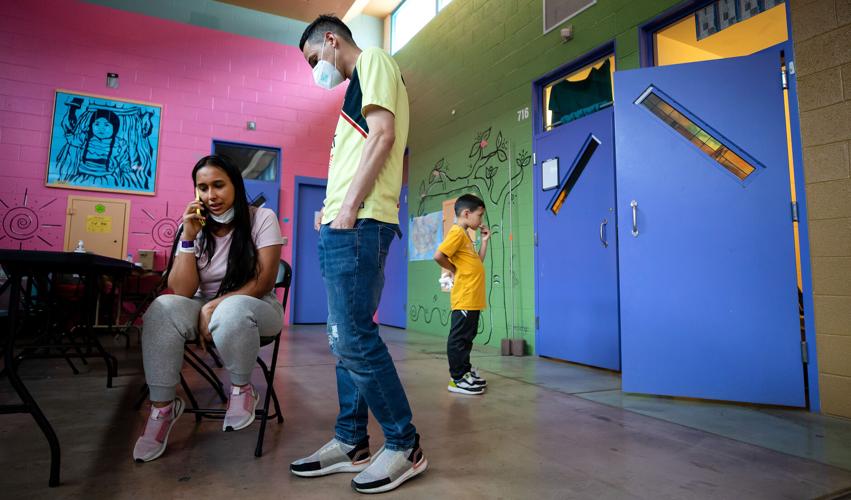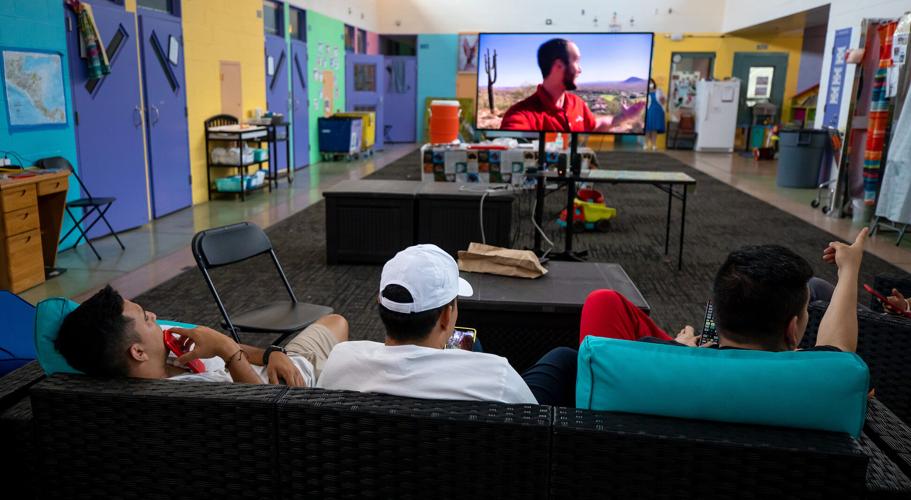Marco Patiño and his family fled Colombia a week before arriving at the migrant shelter in Tucson.
Criminal organizations were threatening him, his wife and child, demanding monthly payments higher than his income from his job at a makeup distribution company.
His uncle had been in a similar situation and had not paid — until the criminal organization kidnapped the man’s son. Then he gave everything he had to get the child back.
“Over there, life is hard. Throughout the country people are being displaced. They take your house and you have to leave. And if you don’t, they kill you,” Patiño said about the criminal organizations.
The number of migrants showing up at the U.S. border with Mexico continues to break records, as does the number who pass through Pima County needing assistance.
In May, the Border Patrol apprehended migrants nearly 239,500 times on the U.S.-Mexico border, the highest number in May on record, which was true for April and March as well.
In Arizona, there were more than 60,000 apprehensions in May, which is also higher than previous months in recent years, though not a record. Arizona has seen higher monthly numbers of Border Patrol agents apprehending migrants many times, including during the Clinton and Bush Jr. administrations.
As well, Casa Alitas Welcome Center, the migrant shelter in Tucson, saw its highest monthly number in May at nearly 6,300 people, which is 2,000 more than any other month.
So far in June, the number of people coming to the shelter has gone down to about 100 to 150 people a day, which is probably because the high temperatures are making it harder to cross.
The increase in migration to the United States is consistent with trends across the globe. Rising levels of violence and worsening economic and political situations, exacerbated by both the pandemic and in some cases climate change, have led to more people being displaced in the Western Hemisphere and the world than any time since World War II.
Under Title 42, a U.S. public health policy, more than 20,000 of the migrants who were apprehended on Arizona’s border in May were quickly expelled from the country without being entered into the U.S. immigration process, almost all of whom were from Mexico, Guatemala and Honduras.
The majority of people who are allowed to remain in the country while they wait to go through immigration court and possibly make an asylum claim are families, many from South American countries and Cuba.
New plans will only help some
President Joe Biden and other leaders from across the Western Hemisphere announced new plans to help manage migration at a Summit of the Americas on June 10.
Measures include the U.S. announcing nearly $340 million for humanitarian aid and support for countries across the hemisphere that are integrating displaced migrant and refugee populations into their respective countries.
Also, other countries, including Canada, Mexico and Guatemala, committed to expanding legal immigration by tens of thousands of people.
The Biden administration also plans to expand legal pathways to migration, through visas for agricultural workers, nonagricultural seasonal workers, and increased refugee resettlement and family reunification.
Although the number of migrants who would be let into all these programs wasn’t announced in a fact sheet the White House put out, the numbers that were provided amounted to migration pathways for just over 30,000 people.
The number of migrants encountered at the U.S. border in the first eight months of fiscal year 2022 alone is much higher than that at more than 1.7 million, though many of those are people who have crossed repeatedly and subsequently were counted more than once.
The United States also committed to a multilateral “Sting Operation” to disrupt human smuggling networks across the hemisphere and to improve the efficiency and fairness of the asylum process at the border.
Most coming into U.S. are families
Patiño and his family fled with almost nothing. They left Colombia a week before, flew to Mexico City and then made their way by land to the border. At one point, Patiño thought getting into the U.S. would be impossible. Now that they’re here, he feels much more relaxed.
From Casa Alitas, they will go to San Jose, California, where he has a cousin and hopes to make an asylum claim. They feel safer now, though they don’t know what their future holds.
“I feel good, but at the same time I don’t because it’s not the same to come here and live the life that you all have here while I know what is happening over there,” he said in Spanish. “It’s not the same. This isn’t a vacation for us.”
Patiño hopes to work and send money home so his relatives in Colombia have food and a roof over their heads, he said. He’s glad to be out of Colombia for as long as possible, even if they aren’t able to gain asylum and have to return.
The majority of people coming to Casa Alitas right now are from Cuba, Colombia and India, said Teresa Cavendish, director of operations for Catholic Community Services, the nonprofit that runs the welcome center.
About half the people coming to Casa Alitas are in a family unit. And some of the single people at the welcome center may have been separated from a partner they were traveling with if they don’t meet the definition of a family as defined by border authorities.
Almost half the migrants who crossed the border into Arizona in May and were entered into the immigration system rather than being immediately expelled from the country were either in a family unit or were unaccompanied minors.
Many of the people coming to Casa Alitas, where they typically only stay for a day, are headed to stay with friends and family in Florida, New York, New Jersey, Texas and the West Coast, Cavendish said.
The higher numbers in May put a strain on the nonprofit organization in terms of space for people to stay and outbound travel because of the increased cost of airline travel. The organization had to expand its existing structure very rapidly, but the funds it has received from the federal government covered the increased costs.
Pima County has received more than $10 million from the Federal Emergency Management Agency since April of 2021 for migrant services such as those that Casa Alitas provides. The funding should last for the next several months, Cavendish said.
‘It’s better to leave’
One day this week, there were a few dozen people at the Tucson center trying to figure out their next step. Many were on their phones. People waited in line to talk to volunteers who make sure they have their immigration paperwork in order. Some are quickly gathering their things to go to the airport.
Many of them crossed the border in the Yuma Sector where the walk from a city to an opening in the border wall is not very long. The number of border crossers in Yuma has been increasing for the last year and a half. Nearly 90% of the Border Patrol encounters in Yuma in May were with people who are from countries farther away than Mexico and Central America’s Northern Triangle of El Salvador, Guatemala and Honduras.
The way criminal organizations were threatening Patiño and his family is similar to what many who flee to the U.S. border are experiencing in Mexico and Central and South America.
Patiño’s father had been a victim of the armed conflict in Colombia. Criminal organizations took his property away about 16 years ago, and he was paying for the land they took from him ever since. When his father died of COVID a year ago, the forced debt transferred to Patiño, he said.
And when he couldn’t pay, they threatened to hurt his wife and son.
“That’s life in Colombia,” he said. “It’s very complicated. The idea that somebody can’t find work there, can’t survive isn’t true. A person can do that. I worked, and I supported my wife and my son. A person can do that much.
“But when you end up in a situation like this, it’s better to leave because I don’t want anything bad to happen to my son.”





